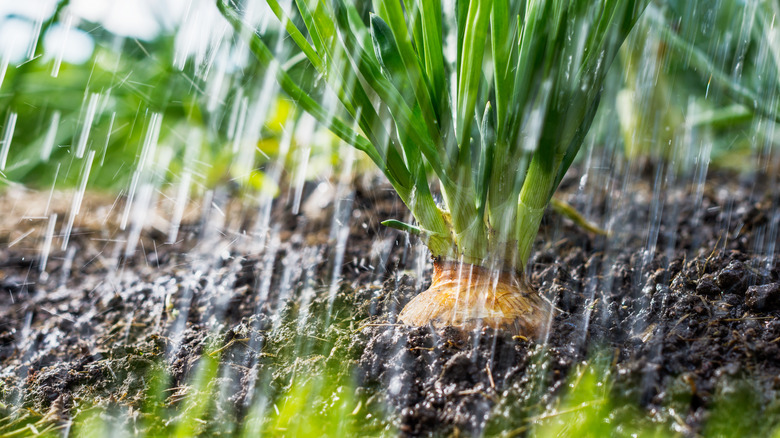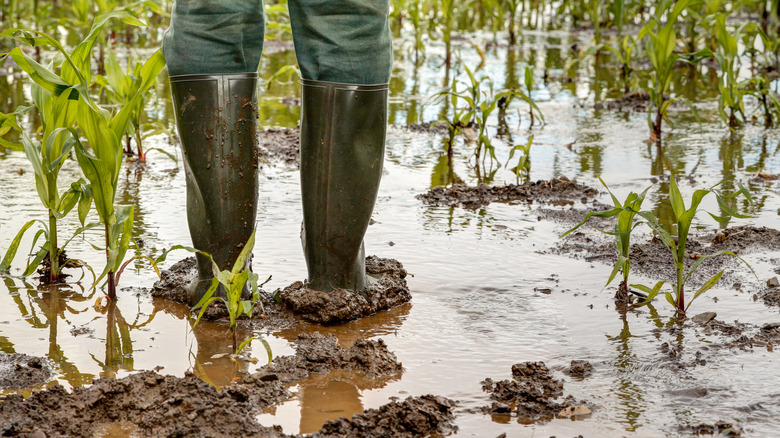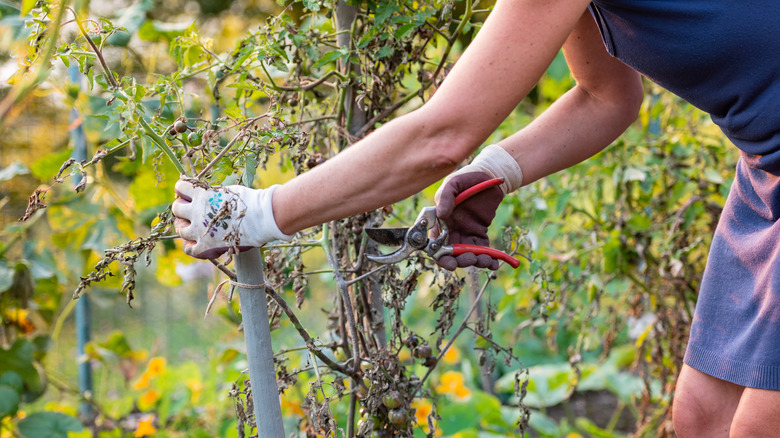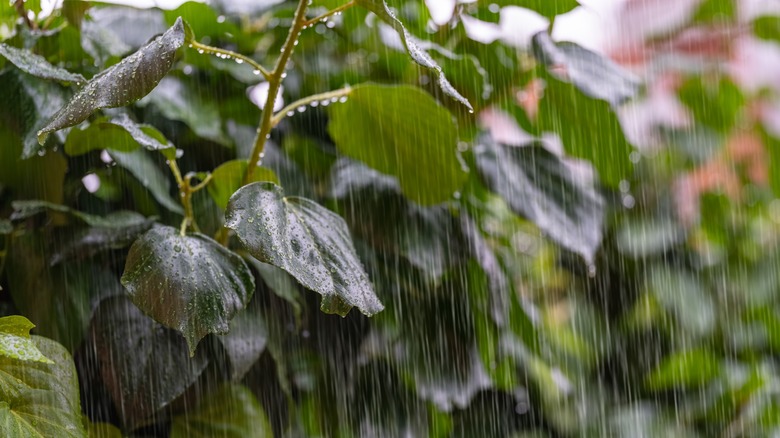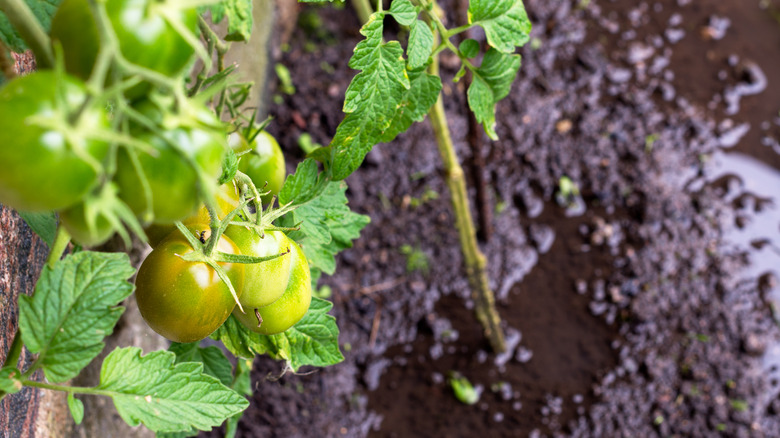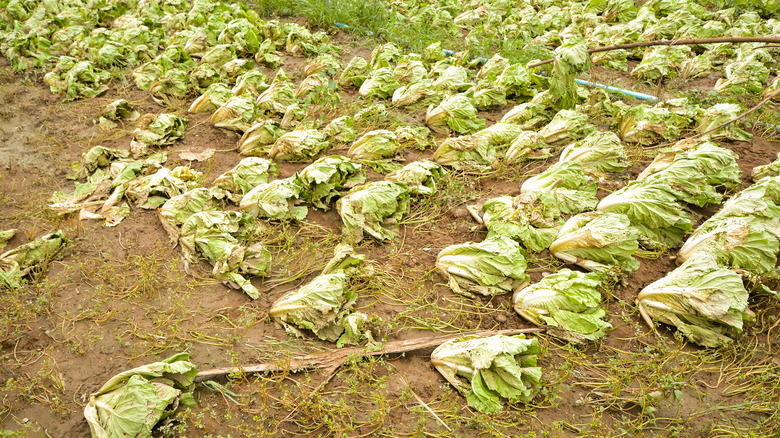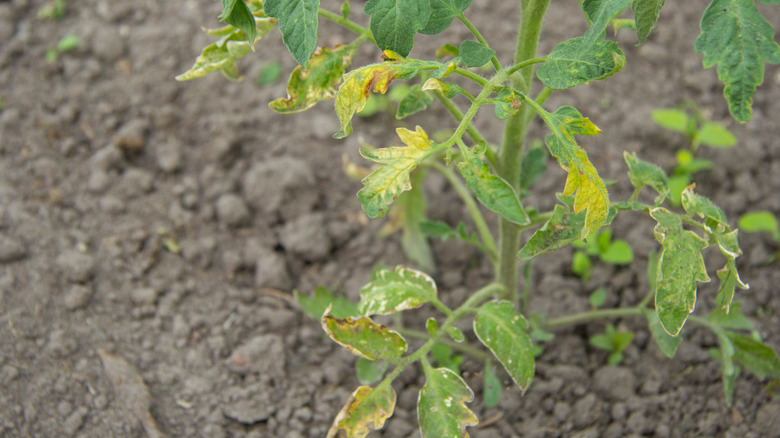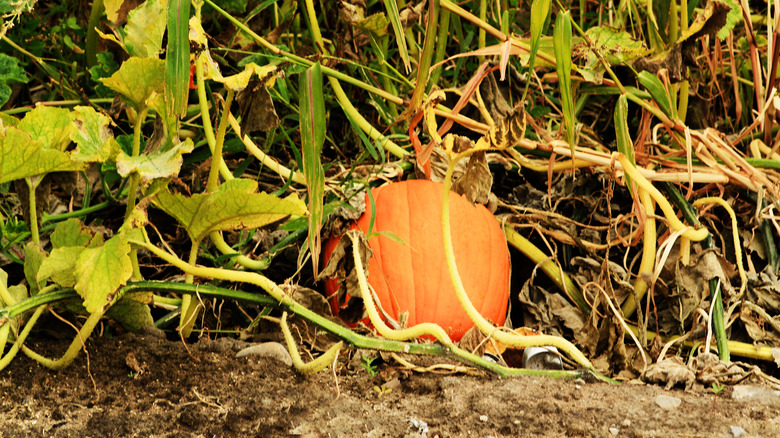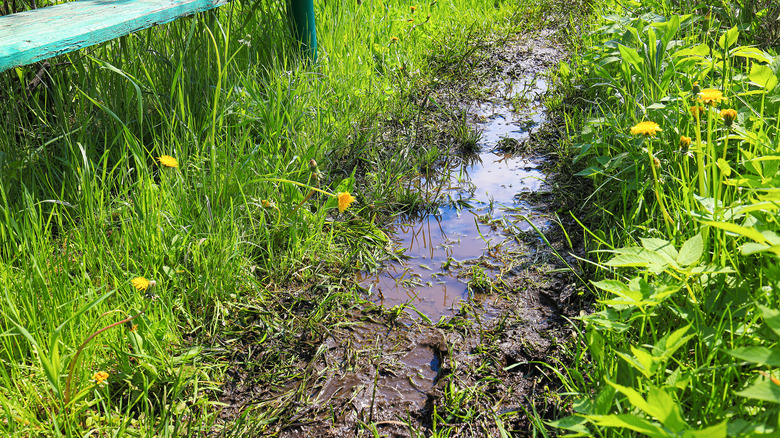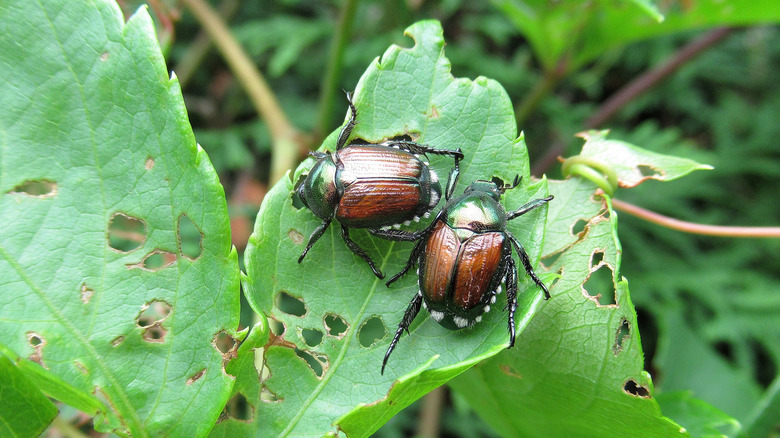What Really Happens To Your Garden During Periods Of Excessive Rain
All plants need water to live, but things can quickly get out of hand in the garden during excessive precipitation. The most obvious issues tend to be that some pests multiply and weeds suddenly grow out of hand, so you really want to tend to those gardening tasks immediately. And if you live in a consistently wet climate, you might consider DIYing your own rain barrel or even constructing a rain garden to catch and filter all that extra water that could do damage if left to its own devices.
Most of us live in fairly average climates, though, and an unexpectedly long period of rain can potentially throw off our garden's health. There are a lot of other things going on in the ground, like flooding, soil compaction, lack of oxygen, and leaching of essential nutrients — all of which we need to be aware of and work to improve.
Compacted soil suffocates plant roots
During and after heavy rains, it's common for the soil in your garden to become compacted, especially if you walk over it or drag wheelbarrows and heavy machinery through it. The water allows fine clay particles to blend together with coarser particles and form dense clumps. This closes off any pores that let water run down to the roots of the plants, and it suppresses oxygen from getting through. It also leaves no room for earthworms and other organisms to do their jobs. With compacted soil, you'll end up with water pooling on top, but not enough of it, if any, making its way below the surface to the roots that really need it. All that water collected above the soil also leads to erosion, but we'll get more into that later.
Avoid problems with compaction by letting the garden rest after a big rain. Tilling soaked soil will just make matters worse, so leave the wheelbarrow in the shed and let the soil dry out before you do anything. For areas that prove consistently problematic, work mulch and compost into the ground once it's dry in order to increase its amount of organic matter. When it comes time to plant for next season, fill in bare gaps with cover crops like oats, clovers, buckwheat, and alfalfa.
Bacteria, viruses, fungi, and mold spread throughout the garden
It's a fact of life that consistently damp environments harbor some forms of bacteria, viruses, and fungi. The pathogens are always there regardless of the weather, but in the right conditions (humid, rainy, etc.), those pathogens will begin to thrive and take over plants with disease.
This issue really comes into play during a long period of rain, and there are some preventative steps that are worth taking to head it off at the pass. Planting disease-resistant crops is first on the list, especially if you live in an area that gets consistent rain. Then comes pruning and keeping the garden clean. Removing decaying foliage and branches literally removes diseased plant parts from the site, and it also opens up space for air to flow through, sunlight to get in, and the plant to start drying out. If the inclement weather blindsides you with no time to prepare, just get back out into the garden as soon as it's safe to do so. Sanitize your tools, look for any signs of rot or decay on your plants, and do what you can to clean everything up.
Decreased sun exposure is tough on plants
A day or two of rain is normal, but when we head into a week or more of it, our plants start to suffer from the constant darkness that comes from the low cloud cover. Lack of sunlight impedes photosynthesis, which means plants cannot convert sunlight, carbon dioxide, and water into the sugar energy they need to survive. Tons of rain might make humans feel sad and lethargic, but it has a much more physically distressing effect on plants.
During a particularly long stretch of dark, rainy weather, you might notice your plants weakening and becoming leggy. Dark green leaves may turn light green or yellow, while variegated leaves may lose any interesting striping and go back to being solid (though pale) green. And flowering plants and shrubs may fail to produce blooms. That said, if you happen to have any shade-loving plants, you can bet they'll be flourishing like never before. The stretch of darkness won't last forever, and your otherwise healthy and resilient garden should bounce back in time once the sunlight returns.
Fewer pollinators present means less fruit and a smaller harvest
Alongside less sunlight comes the problem of fewer pollinators. Many of us look outside on a rainy day and think this is the perfect opportunity to curl up by the fire with a good book, and the same is sort of true for honey bees. Inclement weather means they're calling it quits and staying in the hive for shelter. They don't even like it when it's below 55 degrees Fahrenheit, but they definitely don't come out during heavy rain. There are other bees, hummingbirds, and bats that will stay on pollinating duty in a drizzle, but there's enough that won't, and it makes a difference come harvest time.
Other things that happen are that the nectar in the flowers gets diluted from all the rainwater, and the storm can leave behind damaged or diseased plants; both of these factors make the plant less attractive to pollinators. Finally, a bad storm can be strong enough to wash away bees and butterflies who cannot find shelter. Even just one small raindrop can give a heck of a wallop to a tiny insect, and the overcast skies can make it too cold for them to fly.
Plants fall over and seeds wash away due to flooding and erosion
It's easy to see how flooding and erosion of the ground in which your garden is set will seriously injure plants. Perennial seeds that would have otherwise proliferated in the soil will wash away and either be ruined or end up sprouting somewhere they may not be wanted. Meanwhile, grown plants will lose their footing and fall over. This may not seem like a huge problem for low-to-the-ground crops like lettuce, but what about your towering tomato plants, bean stalks, and corn?
Even with shorter crops, too much contact of fruit and foliage with the ground creates that breeding ground for bacteria and disease. If you expect a lot of rain, head into the garden beforehand to install tomato cages and loosely secure what you can to structural supports. Zip ties, twine, bamboo poles, and plastic or metal stakes will all come in handy. Being proactive with this will help but, unfortunately, the physical problem of plants falling over isn't the only issue brought on by erosion.
Nitrogen is leached from soil which affects photosynthesis
An additional problem with erosion is that it washes away nitrogen, a much-needed macronutrient when it comes to overall plant health. During regular rainfall, it's normal for the topsoil to erode and the runoff to carry away nitrogen and other nutrients. When the soil becomes saturated with excessive water and therefore less oxygen, a process called denitrification starts to happen, in which nitrogen is lost atmospherically. Leaching is yet another way wet soil can lose nitrogen, this time by it seeping down into the ground beyond the reach of the deepest roots.
Whether nitrogen evaporates up into the air, sinks to unreachable depths, or simply washes away, the resulting nitrogen deficiency can put a serious damper on a plant's ability to perform photosynthesis and grow. This is especially true when it's coupled with a lack of sunlight. Talk to a local expert to see if applying supplemental nitrogen will help get your garden back on track after heavy rains. It could be a beneficial quick fix in extreme cases. Later, once things have calmed down, you can focus on longer-term nitrogen-boosting solutions like using compost, adding mulch, and planting beans, peas, and other nitrogen-fixer plants.
Waterlogged soil drowns plants and causes root rot
Houseplant enthusiasts know the bane of root rot too well when it comes to figuring out how to keep an indoor plant properly watered. As outdoor gardeners, we don't think of it as much because the general idea is that the ground will soak up whatever excess is around, and the crops will be fine. Not so during an elongated period of thunderstorms, though. Soil can become so waterlogged that there's nowhere for the extra water to go, and if it doesn't flow away from plant roots fast enough, you can end up with the dreaded casualties of root rot.
The primary reason for a plant's decline in this situation is lack of oxygen and suffocation of the roots; that damage happens to the deepest roots first. Interestingly, when oxygen levels drop too low, plants can no longer take in water either, even though they're sitting in puddles of it. They may survive the rains, and for a little while afterward you'll think that everything is okay. But if the plants experience too much damage and root death, they won't recover and will instead continue to suffer and decline.
Excessive rain leads to excessive weeds
So many plants struggle with too much water, but you know what doesn't? Weeds. While your backyard looks and smells like a swamp and all your precious produce is rotting along the remnants of the rows you so diligently arranged in the early spring, look what's shooting up left, right, and center — weeds! Dandelions, purslane, moss ... everything you don't want is suddenly growing at exponential rates. And, man, they do not quit.
A flush of weeds should be dealt with quickly. Not only is it easier to pull young weeds from the ground with the roots intact, but if you leave them to grow too long, they can really take over the garden. Tall weeds will then create shelter under which smaller weeds will happily thrive. This makes it harder to control the problem with weed killers and herbicides. Lots of these weeds will be perennial in nature, so another benefit of getting them out of the ground quickly is to kill them before they go to seed. If for any reason you're still lacking motivation, consider that a single dandelion plant can spread as many as 15,000 seeds. Now get out there and pull up those weeds! (But not until the soil dries out and the risk of compaction has passed, of course.)
Bugs love high levels of moisture, too
It's not just the unwanted weeds that benefit from all that rain. Bugs thrive too, and unfortunately, it's a lot of destructive bugs like beetles, earwigs, mosquitos, snails, slugs, and aphids that do best. The mosquitos find the pools of stagnant water the perfect place to lay their eggs, while the others enjoy feeding on all that fresh nutrition from the new weeds and whichever of your vegetables and flowers have survived.
Planting pest-resistant varieties may help here, as may growing a wide range of crops. Otherwise, it's difficult to prevent a large influx of bugs from moving in after heavy rains, so the best thing to do is to be prepared with a plan to get rid of them as they appear. Reset any slug traps that will have been washed away, prepare a garlic spray with water and liquid soap, or use toothpaste of all things to banish unwanted bugs from your garden. Just know in advance that it will take some effort, and don't leave your plants to fend for themselves for too long.
